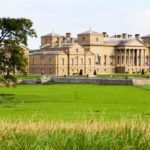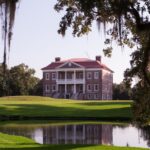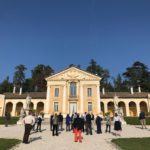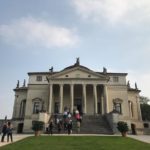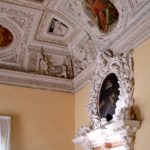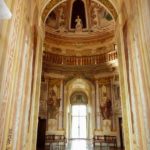Reconciling Palladio in the Veneto and Palladianism Abroad
EVENTS > STUDY TRIPS ABROAD
STUDY TRIP ABROAD FALL 2017 IN REVIEW
The Trust’s fall Study Trip Abroad offered participants a thorough exploration of the Veneto plain that stretches westward from Venice and the Adriatic coast to the Dolomites. While the itinerary did not exclusively focus on the career of famed 16th-century architect Andrea Palladio (1508–1580), born Andrea di Pietro, our participants encountered nearly a dozen examples of his work, from villas and palazzos to churches and civic structures.
Drawing inspiration from antiquity, Palladio was instrumental in shaping the architecture of Renaissance Italy. His influence on later generations of architects practicing in Britain and her colonies is widely touted. We quickly discovered that a visit to sites derived from Palladio such as Holkham Hall or Drayton Hall as the Trust did in 2014 and 2012, respectively, does not offer an adequate understanding the of the architect’s oeuvre. Merely labeling a classically inspired 18th-century dwelling as Palladian implies a monolithic style based on a limited understanding of his work. Palladio’s extant buildings, however, illustrate the impressive breadth and creativity he achieved through his intimate knowledge of Roman precedents.
Although contemporaries such as Sebastiano Serlio, Vicenzo Scamozzi, and Giovanni Maria Falconetto also incorporated a classical idiom, they are virtually unknown outside of academic circles. In fact, Trust Governor and Palladio devotee Helen Scott Reed notes the most oft-cited element of his design vocabulary, the Palladian window, should be more accurately known as the Serlian window for his contemporary who published and popularized the tripartite fenestration, which is based on late Roman precedents. Our participants witnessed Palladio’s success in taking Serlio’s design to new sophistication in Vicenza, where he multiplied the element to create the impressive classical envelope that encapsulates the city’s medieval civic structure, the Palazzo della Ragione.
The layperson may justly ask why Palladio is placed on such a prominent pedestal. He achieved a sterling reputation through patronage, productivity, and publication. After moving from Padua to Vicenza to join the guild of masons and stone carvers, Palladio met Giangiorgio Trissino, an intellectual and humanist who provided the talented stonemason with formal training in architecture. Trissino’s encouragement brought his protégé into contact with many of the patrons that established the architects’ reputation, and Palladio built his classical vocabulary through numerous trips to Rome. Palladio’s I Quattro Libri dell’Architettura (1570) was translated and distributed throughout Europe, thereby cementing his place of honor in architectural history and testifying to the richness and breadth of his training and career.
Palladio’s influence reached Great Britain in two separate phases, a process recounted to our participants by Trust Governor Tom Savage, Deputy Director of Museum Affairs at Winterthur. English theater designer turned architect Inigo Jones visited Italy in 1614 with the Early of Arundel and returned home with a copy of I Quattro Libri and drawings by Palladio acquired from the latter’s student and successor Vincenzo Scamozzi. Jones’ designs for the Banqueting House at Whitehall and the Queen’s House in Greenwich borrow heavily from these sources and introduced Britain to the Italian Renaissance.
The second wave of Palladianism arrived a century later, prompted by a new publication and a new patron of the style. In 1715, Giacomo Leoni, a Venetian architect living in London, published the first full English-translated version of I Quattro Libri, thereby inspiring another burst of classical revivalism. Much of the credit, however, must be given to Richard Boyle, Third Earl of Burlington, a wealthy art patron, collector, and architect who traveled extensively through Italy during three separate Grand Tours between 1714 and 1719. Chisick House in London, Holkham Hall in Norfolk, and the Assembly Rooms in York are the primary extant examples of Lord Burlington’s talent for Palladian design. From England, the vogue for Palladian classicism spread to Scotland, Ireland, and America, where Thomas Jefferson used of the Villa Cornaro for his first design for Monticello and served as a prominent proponent of neoclassical temple-front designs that came to shape public architecture, as relayed by Trust Governor Susan Stein, Richard Gilder Senior Curator & Vice President for Museum Programs at Monticello.
A careful study of Palladio’s villas reveals the influence of patrons and the specific sites on which they were building, particularly their placement on the estate and juxtaposition with the surrounding environment. Published images of the architect’s work do not typically convey the nuances of their setting, whether in the country or in a town. Palladio’s iconic Villa la Rotonda sits outside of Vicenza while the Villa Cornaro is in the thick of a town center, thereby eliminating the winding, processional approach through farm and parkland typical of British and American country houses.
A second primary difference between Palladio’s oeuvre and the dwellings inspired by his style concerns functionality. Much of his discourse in I Quattro Libri pertains to promoting the necessity of useful buildings. Unlike an English villa such as Holkham Hall where barns, stables, and other utilitarian spaces are relegated to out-of-sight regions of the property, Palladio endeavored to seamlessly integrate the components of a working estate. While visiting his Villas Barbaro, Maser, and Emo, we learned that Palladio designed the arcaded ground floors not merely for domestic purposes but specifically to store agricultural products, house livestock, and serve the other necessities of a working farm.
The interior ornamentation of English and American 18th-century Palladian houses also diverge from the architect’s original intent. Palladio envisioned classical temples with chaste interiors wrought from inexpensive materials and largely devoid of ornamentation. His patrons and their descendants strayed from the architect’s recommendation, hiring fresco painters and stuccodores to introduce the extraordinary interiors we encountered this fall. Trust Governor Margaret Pritchard, Deputy Chief Curator at Colonial Williamsburg, posed an insightful question regarding whether English visitors such as Jones and Lord Burlington misattributed the richly decorated rooms to Palladio’s designs rather than successive generations, thus leading them to create more ornate interiors in their Palladian houses back home.
The insight gained from witnessing Palladio’s architectural genius first hand underscores the importance of our Study Trip Abroad program. The experience was particularly revelatory for Trish Smith, Curator of Historic Architectural Resources at Drayton Hall, who received a scholarship to attend. Trish returned to Charleston with “a better understanding of Palladio’s work, a renewed curiosity about the spread of Palladian architecture, and new ideas about how technology might be used to interpret his designs.” A specialist in the use of 3D modeling to create digitally restored historic structures, Trish expects this technique “could also be used to show Palladio’s villas the way he envisioned them.” Thanks to the Trust’s Study Trip Abroad, we can now envision this seminal figure’s impact on architectural history in Europe, the United Kingdom, and British colonies from India to America.
Complete a digital puzzle from this trip on our Puzzles webpage!

